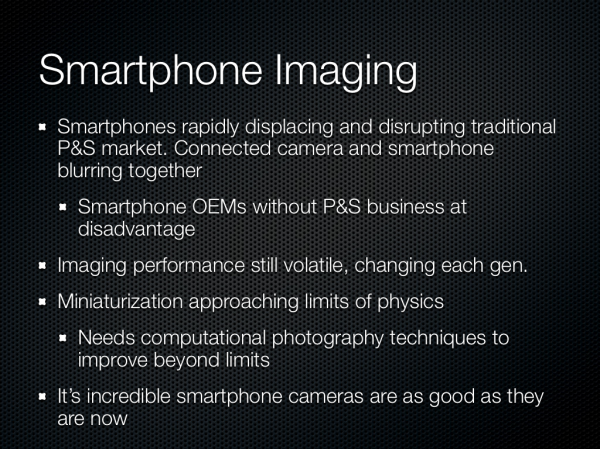Understanding Camera Optics & Smartphone Camera Trends, A Presentation by Brian Klug
by Brian Klug on February 22, 2013 5:04 PM EST- Posted in
- Smartphones
- camera
- Android
- Mobile
Trends in Smartphone Cameras
Recently, I became annoyed with the way Dropbox camera upload just dumps images with no organization into the “/Camera Uploads” folder, and set out to organize things. I have auto upload enabled for basically all the smartphones I get sampled or use on a daily basis, and this became a problem with all the sample photos and screenshots I take and want to use. I wrote a python script to parse EXIF data, then sort the images into appropriate camera make and model folders to organize things. An aberration of having this script put together was easy statistical analysis of the over four thousand images I’ve captured on smartphones from both rear and front facing cameras, and I was curious about just how much storage space the megapixel race is costing us. In addition I was curious about whether there’s much of a trend among certain OEMs and the compression settings they choose for their cameras. The plot shows a number of interesting groupings, and without even doing a regression we can see that indeed storage space is unsurprisingly being consumed more by larger images, with the 13 MP cameras already consuming close to 5 MB or more per image.
If we sort them into bins we can see that most really end up between a few KB in size to 6 MB, with the panoramas and other large stitched composites providing a long tail out to 16 MB or more.
The conclusion for the broader industry trend is that smartphones are or are poised to begin displacing the role of a traditional point and shoot camera. The truth is that certain OEMs who already have a point and shoot business can easily port some of their engineering expertise to making smartphone cameras better, those without any previous business are at a disadvantage, at least initially. In addition we see that experiences and features are still highly volatile, there’s real innovation happening on the smartphone side.













60 Comments
View All Comments
mdar - Thursday, February 28, 2013 - link
You say "This is the standard format for giving a sensor size, but it doesn’t have anything to do with the actual size of the image circle, and rather traces its roots back to the diameter of a vidicon glass tube"The above statement, though partially true, is misleading. The dimension DOES give sensor size multiplied by factor of roughly 1.5. For example if some one says 1/1.8" sensor, the sensor diagonal is ~ 1/(1.8*1.5). The 1.5 factor probably comes from vidicon glass tube.
Infact if some one wants just one parameter for image quality, it should be sensor size. Pixel technologies do improve (like using BSI) but even now a 1/3" sensor size of iphone or samsung or lumia 920 camera can just barely match quality 1/1.8" sensor of 4-year old Nokia N8.
frakkel - Thursday, February 28, 2013 - link
I am currious if you can elaborate a little regarding lens material.You say that today most lens elements are made of plastic. Is this both for front and rear facing camera lenses?
I was under the impression that lens elements in phones still were made of glass but that the industry is looking to change to plastic but this change has not been done yet. Please correct me if I am wrong and a link or two would not hurt :)
vlad0 - Friday, March 1, 2013 - link
I suggest reading this white paper as well:http://www.mediafire.com/view/?0o5oo43h8os4ba9
it deals with a lot of the limitations of a smartphone camera in a very elegant way, and the results are sublime.
http://sdrv.ms/VQ3eCd
Nokia solved several important issues the industry has been dealing with for a long time...
wally626 - Monday, March 4, 2013 - link
Although the term Bokeh is commonly used to refer to the effect in pictures of low depth of field techniques it should only be used to refer to the quality of the out-of-focus regions of such photographs. It is much more an aesthetic term than technical. Camera phones usually have such deep depth of focus that little is out of focus in normal use. However, with the newer f/2, f/2.4 phone cameras when doing close focus you can get the out of focus regions from low depth of field.http://www.zeiss.com/c12567a8003b8b6f/embedtitelin...$file/cln35_bokeh_en.pdf
Is a very good discussion of this by Dr. Nasse of Zeiss
wally626 - Monday, March 4, 2013 - link
Someone fixed the Zeiss link to the Nassw article for me awhile back but I forgot the exact fix. In any case a search on the terms Zeiss, Nasse and Bokeh should bring up the article.huanghost - Thursday, March 21, 2013 - link
admirablemikeb_nz - Sunday, December 22, 2013 - link
how do i calculate or where do i find the field of view (angle of view) for smartphone and tablet cameras?thanks
oanta_william - Monday, July 20, 2015 - link
Your insight in Smartphone Cameras is awesome! Thanks for everything!From your experience would it be possible to have only the camera module on a device, with a micro-controller/SoC that has sufficient power ONLY for transmitting the non processed 'RAW' data on another device via Bluetooth - on which the ISP and the rest needed for image processing to be situated.
I have a homework regarding this. Do you now any reference material/books that could help me?
Thanks!
solarkraft - Monday, January 9, 2017 - link
What an amazing article! Finally something serious about smartphone imaging (the processor/phone makers don't tell us ****)! Just an updated version might be cool.albertjohn - Tuesday, November 20, 2018 - link
I like this concept. I visited your blog for the first time and became your fan. Keep posting as I am going to read it everyday.